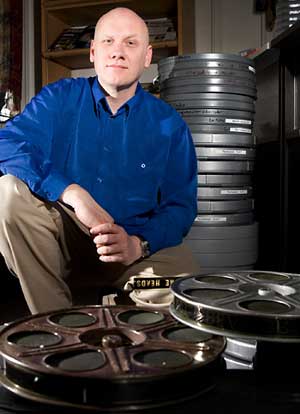On the second floor of the Frieze Building is a film library that puts any Blockbuster to shame. Boasting more than 10,000 DVDs and a slew of films in an array of formats—from laserdisc to 16- and 35-mm—the collection spans the golden age of filmmaking.

“I think it is one of the bigger collections in the state, as far as libraries go,” says Philip Hallman, information resources specialist in the Department of Screen Arts & Cultures, who has built most of the collection since he returned to campus in 1999. “But the thing that separates us from other collections is we have screenplays.”
Almost half of the room encasing the Donald Hall Collection—created from a $1 million gift from alumnus Robert Shaye and his Four Friends Foundation—is lined with 12-foot bookshelves packed with screenplays from more than 2,000 films. A glance at one shelf brings readers eye-to-eye with alumnus Arthur Miller’s classic “Death of a Salesman.” There are timeless movies, like “Gone with the Wind,” and films that won’t be mistaken for Oscar winners, including “Beavis and Butthead Do America.”
Hallman, who earned a bachelor of arts in film and video studies and history of art from U-M, and a master of arts in cinema studies from NYU, says perusing screenplays from a variety of films, even the forgettable “Police Academy” series, is helpful to students.
“We do try to get good and bad,” Hallman says. “One of the professors has an assignment to read a bad screenplay because you can learn a lot more about a movie if it is bad, especially at the young writing level.”
The screenplays can be checked out for one week, Hallman says; however, the remainder of the library collection must stay in the room. He says the library mainly is used by faculty, staff and students in film and video studies, but adds it is open to the campus community.
Hallman has a goal to obtain the screenplay for every film in the library, an ambitious undertaking given the large collection filling numerous black filing cabinets around the perimeter of the room. He is well on the way, however, to making the collection what he envisioned when he arrived to find a small number of laserdiscs and little else.
The Hall collection contains more than 2,000 16-mm and 400 35-mm films that are shown on reel-to-reel projectors. Many are old and must be stored in a climate-controlled room on campus. Hallman uses many of them for the Projectorhead Film Series, which is shown Thursday evenings in the Modern Languages Building.
“Some are originals, including 1960s musicals,” says Hallman, who has copies of “Funny Girl,” “My Fair Lady,” and “Around the World in 80 Days,” among others. “They look just amazing on a wide screen.”
Hallman spends many hours making sure the library has the latest films, but he also tries to fill in holes with historical purchases. He says the Internet is a great place to find rare and out-of-date films but the shopping is not always easy.
“I got involved in this intense bidding war on eBay for this laserdisc collection by Japanese filmmaker Yasujiro Ozu,” Hallman recalls. “I came into work because the auction was ending at midnight on a Saturday. I ended up getting [outbid] in the last 10 seconds.
“Strangely enough, a few days later someone contacted me and said they had the same collection.”
Hallman says he is surprised so many films and television shows are on DVD. “For a long time, there were a lot of important TV shows from the 1980s that were unavailable—”Moonlighting,” “Murphy Brown,” “Hill Street Blues.”
Although surrounded daily by almost any film one would want to see, Hallman admits to having a very small DVD collection at home. He is, however, a movie buff who likes to see films in a theater, when possible. He has attended the Toronto Film Festival for years, taking in sometimes 45 movies in 10 days. “Four films a day is doable; five is pushing it; six is punishment,” he says.
Collecting new DVDs and older films is a passion and a job for Hallman, but he says nothing can compare to taking in a movie at the drive-in theater. Hallman says his father owned a drive-in theater in Wayne that closed in 1991.
“When I would go, it would be an all-evening experience,” he says. “You would get all excited to go, then play on the playground for a while, then the movie would start and you would go to the snack bar.”
While many such theaters are gone, Hallman still makes an effort to attend when he finds one. “I have been going since age 3 and still go every year.”

